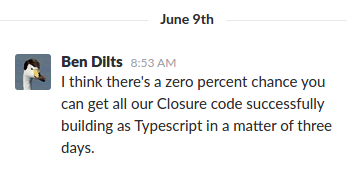Background
Users have been using Lucidchart for a long time to make their diagrams, since 2010 and IE6. And for nearly that long, Lucid has used Google's Closure Compiler to manage its increasingly sophisticated code base. Closure Compiler is a typechecker and minifier that uses JSDoc annotations in comments to understand type information. As Lucid grew from 5 to 15 to 50 engineers, the tool proved enormously helpful for quality and productivity. Then in 2016, Lucid began experimenting with TypeScript. TypeScript offers more flexible and comprehensive type checking, cleaner syntax, and better IDE support than we could get with Closure-annotated Javascript.// Closure JavaScript
/** @const {!goog.events.EventId<lucid.model.DocumentEvents.PagesContentChanged>} */
lucid.model.DocumentEvents.PAGES_CONTENT_CHANGED =
new goog.events.EventId(goog.events.getUniqueId('PAGES_CONTENT_CHANGED'));
/**
* @constructor
* @extends {goog.events.Event}
* @final
* @param {!Object<boolean>} pages
* @struct
*/
lucid.model.DocumentEvents.PagesContentChanged = function(pages) {
lucid.model.DocumentEvents.PagesContentChanged.base(
this, 'constructor', lucid.model.DocumentEvents.PAGES_CONTENT_CHANGED
);
/** @const {!Object<boolean>} */
this.pages = pages;
};
goog.inherits(lucid.model.DocumentEvents.PagesContentChanged, goog.events.Event);
// TypeScript
export const PAGES_CONTENT_CHANGED: EventId<PagesContentChanged> =
new EventId(events.getUniqueId('PAGES_CONTENT_CHANGED'));
export class PagesContentChanged extends Event {
constructor(public readonly pages: {[key: string]: boolean}) {
super(PAGES_CONTENT_CHANGED);
}
}
Idea
Every summer, Lucid has a two-day hackathon during which Lucid employees work on an interesting project of their choice. The hackathon presented a unique opportunity to migrate to TypeScript while no production-ready code was being authored. Compared to an active migration, a stop-the-world migration could be much faster and less overall effort.

Google has an open-source tool called gents (generate TS) which converts Closure-annotated JavaScript to TypeScript. The tool has many caveats and limitations — bare-bones, idiomatic code translates well, but more unusual code and sophisticated language features (e.g. generics) do not. Initially, gents crashed with runtime errors on Lucid’s codebase. A few patches got gents to about 80% of what we needed. Ad-hoc pre- and post-processing scripts added an additional 10%. Even then, the remaining 10% was still enormous in absolute terms and would possibly be too large to complete in a couple days. We asked our CTO to join in the migration. He supported the idea but preferred working on a project more within the realm of possibility.

Plans
A very challenging aspect of the migration would be the lack of feedback. Computers are picky things; 70% of code working looks a lot like 0% working. While it would be difficult to get incremental runtime feedback, we decided to at least get incremental compile-time feedback. We would create a dependency graph of the 2000+ files and start working from the leaves, moving each file to a new source root, fixing the type errors, and committing it. At any given time, we would have a set of successfully compiling TS files. To parallelize this effort across the six engineers, we constructed a 2,840-line spreadsheet with each files, its status, and its dependencies. Once a file's dependencies were marked completed, the file would be color coded as ready for work. One of us would self-assign it, move it, fix it up after automatic translation, and mark it as done. Then that process would repeat on the remaining files.
Hackathon
To process all 2,840 files, we needed to complete one file per minute for 48 hours straight. The six of us worked around the clock, sleeping only a few hours during the two-day hackathon. Some files had cyclical dependencies (allowed, as long as some of the dependencies are type-only rather than value dependencies), and we frequently had to tackle large groups of files all at once. Velocity varied. Twenty hours in, prospects looked bleak. This was disappointing, as partial success for this hackathon project was the same as no success—there would be too many conflicts if this project had to be extended into a normal working day. There were several recurring challenges: 1. Base constructor requirements are different between Closure JS and TS. Complex, overgrown inheritance trees with tricky initialization semantics were challenging to re-architect. 2. TypeScript is more aggressive than Closure Compiler at identifying errors. For example, tsc detected the assignment-vs-comparison mistake that Closure Compiler did not:var usernameOnTeam = (alreadyOnTeamFilter['usernameOnTeam'] || []).map(onTeam =>
goog.array.find(me.loadedUsers, user => user.username = onTeam.username);
);
Release
Of course, the story was far from over. We still needed to ship it. Lucid releases every two weeks and has not missed a release for over four years. The next two weeks were spent getting secondary parts of the product functioning, unit tests passing, tree-shaking and minification working (still using the Closure Compiler), and CI running. QA made multiple passes, finding dozens of bugs. When release day came, every team had a member on call in case of problems. Though we had worked hard to ensure everything would run smoothly, we anticipated something within the half a million lines of a seven-year-old code base to go wrong. We waited and waited. And the issues never came. The combination of unit tests, manual testing, and a new, very robust type system bought us a TypeScript migration with zero customer-facing issues.
About Lucid
Lucid Software is the leader in visual collaboration and work acceleration, helping teams see and build the future by turning ideas into reality. Its products include the Lucid Visual Collaboration Suite (Lucidchart and Lucidspark) and airfocus. The Lucid Visual Collaboration Suite, combined with powerful accelerators for business agility, cloud, and process transformation, empowers organizations to streamline work, foster alignment, and drive business transformation at scale. airfocus, an AI-powered product management and roadmapping platform, extends these capabilities by helping teams prioritize work, define product strategy, and align execution with business goals. The most used work acceleration platform by the Fortune 500, Lucid's solutions are trusted by more than 100 million users across enterprises worldwide, including Google, GE, and NBC Universal. Lucid partners with leaders such as Google, Atlassian, and Microsoft, and has received numerous awards for its products, growth, and workplace culture.
